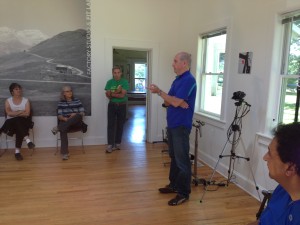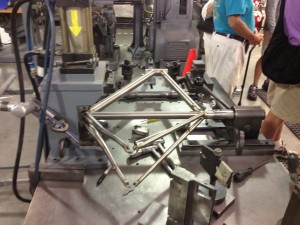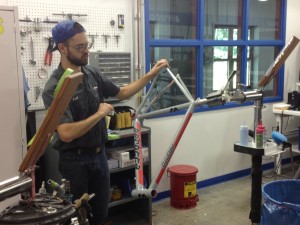
Last month I got a tour of Serotta Bicycles, a world-renowned high-end facility located in my little town of Saratoga Springs, New York. These bikes cost from $4800 to over $28,000—and that’s just the frame. But the painstaking details make it seem worthwhile—from a machining process that can take a stock titanium tube and give it 3 different diameters and three different thicknesses, so it has light weight along with the perfect balance of strength and flex at every point along its length. The total process from beginning to end takes about 40 hours to produce a finished frame; the shop turns out an average of 3 per day.
All the other visitors were current owners who’d come to see the mother lode, and there were esoteric questions about discontinued models and “why don’t you use steel anymore?” (Google that one with Serotta in the search box.) Finally I had to ask the question, why does it take 40 hours instead of 39 or 41? How do you know when it’s done?
Founder and President Ben Serotta said it’s about the “quality of time”. He wouldn’t amplify on that and when I asked a local bike evangelist and Serotta enthusiast to explain it to me, he was silent. So there’s a bit of mysticism afoot here and I will make a couple of educated guesses.

First, quality of time means diminishing returns. As nearly perfect as these bikes are, the finish will never be completely immaculate. (Even though in the final polishing step they use 2500 grit sandpaper, which feels as smooth as a baby’s bottom.) There’s got to be a point when an hour produces so much less benefit than the hour preceding it that you’re spending your own money or raising the price for no good reason, so you stop. Second, bicyclists spend a lot of time in the saddle. If incredibly subtle details can make for a more productive or efficient or competitive ride and so improve their quality of time, they’re worth doing.
Both these hypotheses have application in copywriting. As a creative practitioner, I charge several times what a junior copywriter would charge and there are people who charge several times more than me. Here the time you are paying for is experience—the knowledge and instinct based on past work that a particular message and way of presenting that message will work better than all others. It’s probably not necessary to hire a senior copywriter to write a coupon for your dry cleaning establishment; someone who can follow basic common sense marketing rules (and mayn can’t) will be fine. But if you’re planning to mail millions of people or launch an elaborate website, then the cost of the creative becomes a relatively minor one and it pays to pay more for the best.

The other way to look at “quality of time” is in the experience of the user—the prospect or retail customer who is the recipient of your message. The more time you spend understanding that person’s preferences and motivations—whether through research or hunches—the better their experience is going to be when they receive your message and the more likely they will respond positively.
I may never be able to afford a Serotta bike but it’s something to aspire to—especially because the way to making the money to buy one lies in maximizing my own quality of time.